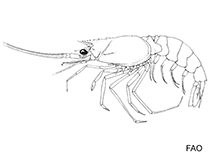Haliporoides diomedeae (Faxon, 1893)
Chilean knife shrimp| Native range | All suitable habitat | Point map | Year 2050 |

|
| This map was computer-generated and has not yet been reviewed. |
| Haliporoides diomedeae AquaMaps Data sources: GBIF OBIS |
Google image | No image available for this species;
drawing shows typical species in Solenoceridae.
Classification / Names Populärnamn | synonymer | CoL | ITIS | WoRMS
Malacostraca | Decapoda | Solenoceridae
Environment: milieu / climate zone / djupintervall / distribution range Ekologi
; djupintervall 240 - 1865 m (Ref. 83922). Tropical, preferred 23°C (Ref. 107945); 11°N - 44°S, 86°W - 71°W
Distribution Länder | FAO områden | Ekosystem | Förekomster | Utplanteringar
Eastern Pacific: Costa Rica to Chiloe, Chile.
Length at first maturity / Size / Weight / Age
Könsmognad: Lm ? range ? - ? cm Max length : 10.1 cm CL hane/ej könsbestämd; (Ref. 8); 21.5 cm TL (female)
Life cycle and mating behavior Könsmognad | Reproduktion | Lek | Eggs | Fecundity | Larvae
Main reference
referenser | Koordinator | Medarbetare
Faxon, W. 1893 Reports on the dredging operations off the west coast of Central America to the Galapagos, to the west coast of Mexico and in the Gulf of California, in charge of Alexander Agassiz, carried on by the U.S. Fish Commission steamer Albatross during 1891 expe Bulletin of the Museum of Comparative Zoology (Harvard College, Cambridge, Masachusetts) 24:149-220. (Ref. 21)
IUCN Red List Status
(Ref. 130435: Version 2025-1)
CITES status (Ref. 108899)
CMS (Ref. 116361)
Threat to humans
Human uses
Fiskeri: kommersiell
FAO - fiskeri: landings | FishSource | Sea Around Us
Verktyg
Ytterligare information
Max. ages / sizes
Length-weight rel.
Length-length rel.
Length-frequencies
Mass conversion
Abundans
Internet-källor
BHL | BOLD Systems | CISTI | DiscoverLife | FAO(fiskeri: ; publication : search) | Fishipedia | GenBank (genome, nucleotide) | GloBI | Gomexsi | Google Books | Google Scholar | Google | PubMed | Tree of Life | Wikipedia (Go, sök) | Zoological Record



